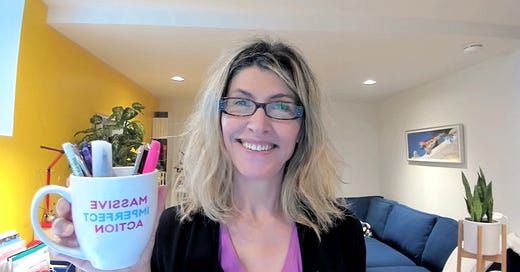Are You Leaving Learning on the Table?
How Well-Intended Leaders, Coaches, and HR Aim Too Low and Reach It
Personal Note: This is the first chapter of my upcoming book about my personal and professional transformation (really transformING). "Are You Leaving Learning on the Table? How Well-Intended Leaders, Coaches, and HR Aim Too Low and Reach It" is my Living Systems approach to Learning and Organization Development after 30 years in traditional corporate approaches. I’ll share each subsequent chapter as I write it and welcome your questions and reactions.
I Loved Her, Then Rejected Her
That’s Carol Sanford I’m referring to, prolific author, Ted Talk presenter, change maker, and Positive Contrarian. I was hooked by her invitation to find my “entrepreneurial spirit, freedom, and a self-directed life.” Her refreshing message rejected the sacred cows I’d revered during my corporate learning and organization development career. Carol’s message was definitely off the traditional grid. I loved it.
As a life-long learner, I devoured her refreshing, contrarian content, from books to podcasts. It contradicted most of what I had learned over decades of study. Admitting she had a point was humbling. Yet the more I learned about her proposed Regenerative approach, the more I realized it wouldn’t suit my company’s leaders. They expected the traditional transactional methods they were accustomed to.
Carol’s unconventional Living Systems approach originates from indigenous wisdom traditions, quantum science, philosophy, contemplative practices, and decades of successful results. Yet, as much as I loved her ideas about Regeneration, I concluded that they weren’t suited to my company’s action-oriented, operational, problem-solving leaders.
Darnitt. Why did she have to use cumbersome and ambiguous terms? Couldn’t she dumb it down a bit? I gradually stopped following her. Not because I didn’t believe in her disruptive and vibrant message — I did. Yet, I feared my credibility would suffer indirectly if I introduced her to my leaders.
Sadly, I moved on by rationalizing: My busy business leaders wouldn’t tolerate Carol. She’s too academic. They don’t have the patience to translate her awkward and opaque words into their practical business realities. So, I continued the safer, well-worn Learning and Development path. With two graduate degrees, certifications, and decades inside global corporations, I only needed to download what I had previously done from my trusty thumbnail drive. No innovation required.
Need team building? Copy-paste and rename a previous PowerPoint. Done.
Another Change Management? Copy this from the last reorganization.
Want Core Competencies? Sure. In segmented levels or one-size-fits-all?
Fast forward two years later, during my evening jog. I found my ear glued to Carol’s podcast, “Business Second Opinion.” Her terminology hadn’t changed, but two years wiser, I rose above my judgments - the core message was too compelling to be distracted by the wording.
Had Carol read my diary? She voiced the contradictions, criticisms, doubts, and disappointments about my work head-on.
I soon joined her Change Agent Development (CAD) community and other learning. She wasn’t a good fit for my company, yet I wanted to learn more. I've never found anything so deeply developmental in my 30 years of what I had thought was “best in class” from top experts, books, and gurus.
Worldview Paradigms
During a CAD session, Carol offered the Levels of Paradigm framework to surface implicit models, hidden worldviews, and outdated thinking in our work. Since I worked in Human Resources, I decided to evaluate the Performance Management and Succession Planning processes through the Levels of Paradigm framework. Secretly, I doubted I’d learn anything new given my long history of working with these global HR processes. I was wrong!
The definitive turning point was assessing my work through a systemic framework and coming to my own conclusions. (That’s an important note. No external expert told me the answers, which built my own will and motivation).
I mapped the underlying thinking of my work processes against three different worldview paradigms:
Machine (Linear, Reductionist, Control Process)
Behaviorist (External Motivation, Authority, Control People)
Human Development (Human-centered, Self-actualization)
Living Systems (Self and Systems actualization, Developmental)
Evaluating our Talent Management processes against the four paradigms was humbling. Despite relying on modern best practices, my work was anchored in incomplete and outdated perspectives: the Behavioral and Human Development worldviews. My dismal self-evaluation inspired me to build deeper critical thinking and discernment skills. What other hidden paradigms and unintended consequences would I uncover? I felt motivated to break through existing boundaries and develop ‘fit-for-the-future’ leaders based on a Living Systems perspective.
Ratings and Rankings and Feedback, Oh My!
Leaders want control over their businesses in a constantly changing world. So, for decades, I taught managers and HR the best practice Talent Management processes from the top consulting firms. The aim? To differentiate employees into discreet buckets.
Segmenting and slotting our Talent gave leaders the false presumption of precision, accuracy, and control in a world of constant change and flux.
Using their “best in class” methods for Performance Management, I trained our managers to:
Rank and reward employees using a guided distribution curve.
Rate ~80% as average, and ~20% above or 10% below average.
Distribute bonuses based on their bell curve placement.
To ensure we had ‘fit-for-the-future leaders,’ we rolled out Succession Planning annually and trained our leaders to:
Slot successors into a 9-box grid for promotions and development.
Use three categories: High Potentials, Low Potentials, Less Potentials.
But wait, it gets worse! My research led me to Marcus Buckingham’s presentation on the inaccuracies of rating performance. Feedback and ratings of others say more about the rater than the ratee - OUCH!
Marcus Buckingham: The Idiosynchratic Rater EffectAs a learning professional, that was an irreversible inflection point — I was completely ashamed of my self-assessment results. The underlying assumptions of my best practice processes were sourced from flawed thinking! Where else had blind compliance with expert authorities resulted in offering outdated thinking to our beloved people?
Incredulous, I dug deeper and found this work by Todd Rose, former Harvard professor and director of the Laboratory for the Science of Individuality.
“Our modern conception of the average person is not a mathematical truth but a human invention, created a century and a half ago by two European scientists to solve the social problems of their era.” - Todd Rose, The End of Average
After assessing Talent Management, I reviewed our Learning & Development menu. With the best intentions, I realized our plug-and-play menu of training, workshops, and webinars was fragmented, reductionist, and piecemeal. Rather than sourcing our offerings from an agreed-upon paradigm and pedagogy, we offered a mishmash of Behavioral-based and Humanist training programs.
“Satisficing” Doesn’t Satisfy
After that decisive moment of truth, I asked Colin, our Talent Analytics Lead, for a report on our succession planning process. Through my guidance, I instructed our senior managers to plot their team members into one of nine boxes based on performance and potential. Colin pulled the data analytics from our HRIS system, Workday, and reported the following findings:
76% of new senior managers were external hires (NOT the internal Talent we committed to develop and promote)
62% of Top Talent were in the same role for 3+ years (in a holding pattern)
23 people working in Critical Roles were in the “Less Effective” boxes
My reflections and research motivated me to find a better solution. And I learned the beloved 9-box tool I had used religiously for decades originated in 1970 - when ashtrays sat on every desk! GE & McKinsey developed it to prioritize business investments. Then, HR adopted it to prioritize people.
I relied on and obeyed the expert authorities, blindly trusting their best practices without questioning the “source of thinking” that produced them.
Now I can see that we were “satisficing,” a term Nobel Laureate Herbert Simon coined by combining “satisfy” and “suffice” to explain the psychology behind our decision-making processes.
Classical economic theories assume that individuals and organizations aim to “maximize” outcomes by exploring all available options before choosing. Yet, in our complex and rapidly changing reality, we often settle for a “good enough” practical solution rather than doing the work to discern the absolute best option. We don’t have time to evaluate every option, so we “satisfice” by seeking the first sufficiently satisfactory solution.
What I Can’t Un-See
I’ve read stacks of books and joined numerous programs related to regenerative living, leadership, and business. Today, after six intense years of learning, I rely on two main approaches: Carol Sanford’s Seed Communities and The Regenesis Institute for Regenerative Practice. Based on Living Systems First Principles, their methodology offers a cohesive epistemology of ancient wisdom, quantum science, contemplative practices, and real-life results. (Additional information will follow).
The more I learned about Living Systems thinking, the more I had to unlearn. The more I saw, the more I could not un-see.
Many well-meaning consultants, coaches, and experts have recently joined the Regenerative bandwagon. Yet, which paradigm are they using: Machine… Behavioral… Human Development… or Living Systems? To create next-stage development, we must deliberately choose the underlying paradigm that sources our offerings. We typically omit this part (I did), resulting in well-meaning facilitation techniques, plug-and-play training, or nature-based walkabouts. They feel good but lack a coherent epistemology and developmental approach for transformation.
More to come as I continue to practice imperfectly…
Next Chapter: “Paradigm Blindness.” I welcome your questions and reactions.🙏






Reading first chapter influenced me deeply. Made me question the direction I want to pursue professionally. Thank you so much.